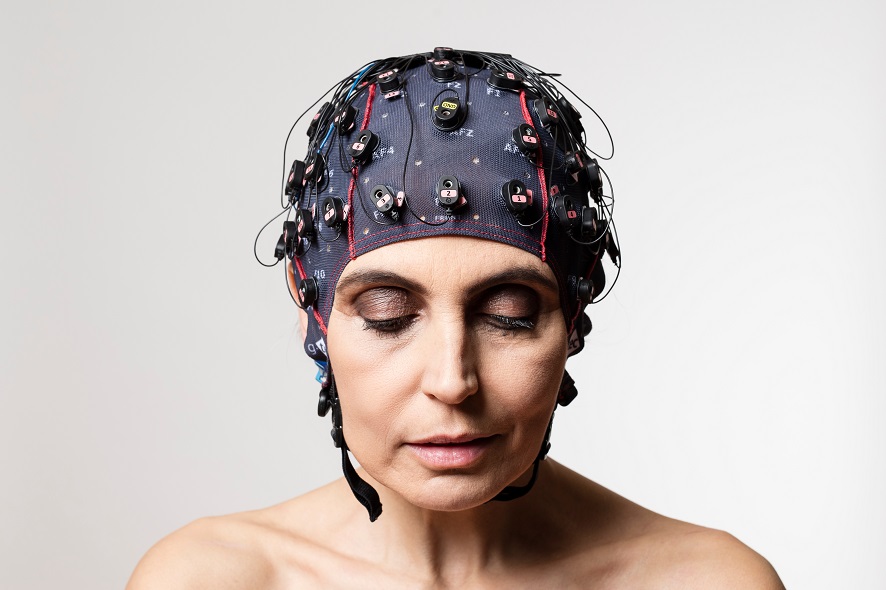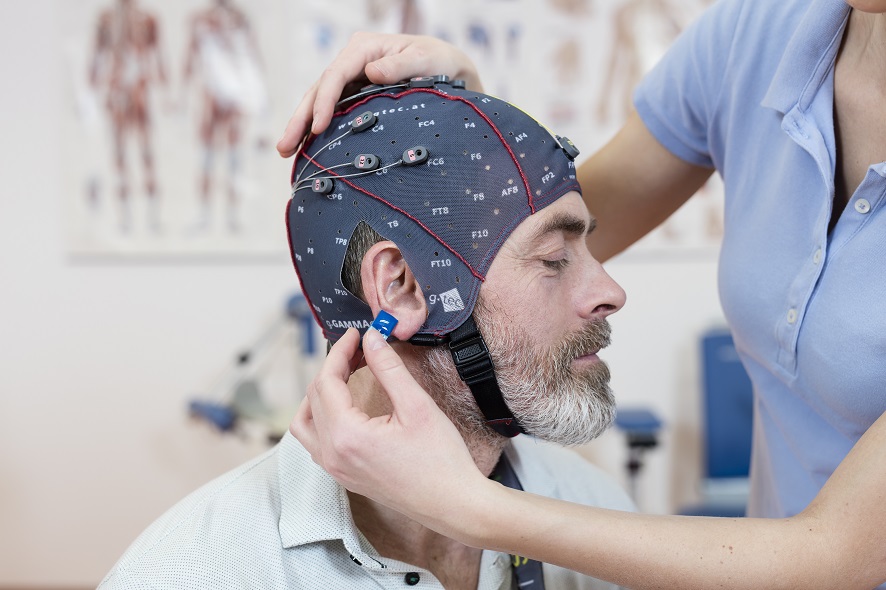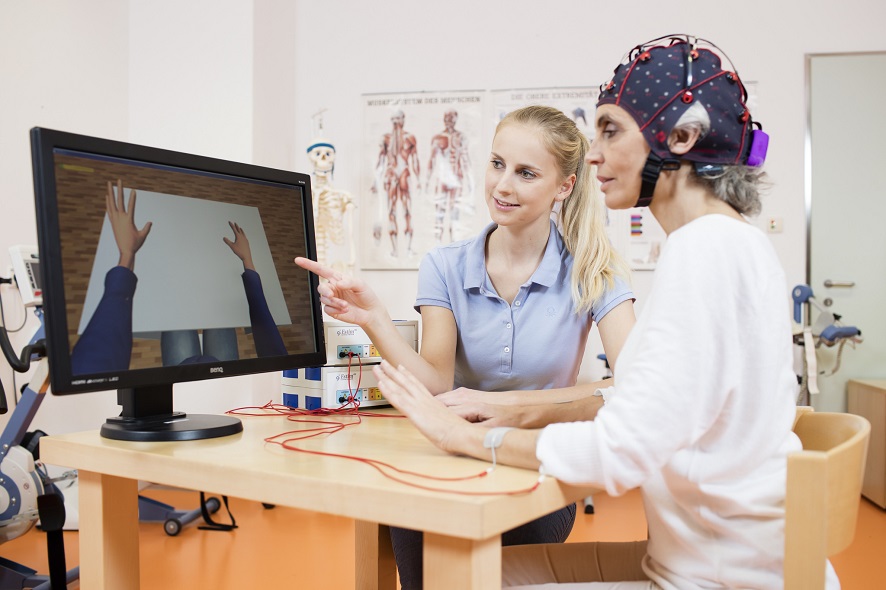“We train directly with the brain here,” explained Sarah Breinbauer, marketing & event manager at g.tec, and meant her explanation to be taken literally. The Upper Austrian medical technology firm develops brain-computer interfaces (BCIs) that achieve astounding therapeutic progress with stroke patients.
What often seems simply impossible with other ways and means becomes quite feasible indeed with a brain-computer interface—motor skills return, states of consciousness on the part of coma & locked-in patients can be accurately ascertained, and the convenient devices of the firm’s Unicorn Suite function as practical aids for home use.
At”Bugfix the Brain” at the Ars Electronica Festival (September 6 -10, 2018) you can find out more about g.tec‘s developments – patients, carers, family members, therapists, and neurologists can register for an appointment with Sarah Breinbauer (E-Mail: breinbauer@gtec.at). In this interview, she told us more.
At the 2018 Ars Electronica Festival, g.tec will be demonstrating some of the innovative technologies developed for its therapy center in Schiedlberg. Can you briefly tell us what you’re working on and with here?
Sarah Breinbauer: For many years, we’ve developed brain-computer interfaces (BCIs) to measure patients’ brain waves. We use them in a variety of ways—for example, in stroke therapies. In Schiedlberg, we set up the recoveriX Gym in which we’ve developed a BCI-based system that physiotherapists and ergotherapists can use on stroke patients. Our patients include people suffering from chronic physical disabilities with their arms, fingers and hands, people who’ve already exhausted all other rehab possibilities. Many don’t really have the option of receiving additional therapy for the simple reason that nothing helps. Maybe they were already in physiotherapy or long-term rehab. But with our recoveriX stroke therapy, they do see an improvement, even decades after a stroke. And it’s wonderful to witness this!
For instance, we have a patient who had a stroke 20 years ago and has been physically handicapped ever since. She had assumed that she will simply not get better and learned to live with her disability. For a long time, she couldn’t more her hand properly. Then she came to us and underwent 25 recoveriX units, and all of a sudden, she could take things in her hand and hold them tight! That had been impossible for years. We achieve this kind of improvement with recoveriX. It’s really special.

Credit: Florian Voggeneder
Why does recoveriX work so well?
Sarah Breinbauer: recoveriX makes it possible to work on the brain itself and to train the brain itself. A patient sits in front of a monitor and is assigned the task of thinking about a particular hand motion. But s/he is actually unable to execute this motion because the body was disabled by the stroke. The point of recoveriX therapy is to think about the motion, whereby the brain goes through almost exactly the same activities as it would when executing the motion. The BCI measures this brain activity and transmits it in real time to a computer. On this basis, there are then various feedback mechanisms—for example, a virtual avatar moves a virtual hand. The patient receives visual feedback at the same time s/he thinks about the hand motion. This is very effective. This has certain similarities to mirror therapy; it’s strongly based on it. Another form of feedback is that the patients are outfitted with muscle stimulators on the disabled hand, which means that there’s not only visual feedback via the avatar but also actual muscle stimulation. This is haptic feedback, and results in the brain learning new ways to perform this motion again. This stimulates the periphery and improves brain plasticity, as this is called in technical lingo.

Credit: Florian Voggeneder
In addition to recoveriX, g.tec will also be demonstrating mindBEAGLE and Unicorn Speller. Tell us about the technology behind them.
Sarah Breinbauer: mindBEAGLE is a system used for coma assessment. It enables neurologists to find out if coma or locked-in patients who are unable to articulate are conscious or not. We’re often not 100% certain if these patients perceive their environment. With this system, you measure the individual’s brain waves, pose various questions or assign various tasks, and thus attempt to ascertain if they’re conscious. With mindBEAGLE, you can see whether a patient understands the task or the instructions, whether s/he can imagine hand motions or register the surroundings. This is great for neurologists because it improves diagnoses, and the therapy sequence can be adapted accordingly.

Credit: Florian Voggeneder
And what is Unicorn Speller’s job?
Sarah Breinbauer: The Unicorn Suite is an affordable BCI system we’ve developed. People with physical handicaps can use it, for instance, to write on a virtual keyboard, control robots or household appliances, or draw pictures. It’s very easy to use, since the point was to make it user-friendly for people who need a system like this.
These three very innovative systems will presented at Bugfix the Brain during the 2018 Ars Electronica Festival …
Sarah Breinbauer: Right. The Bugfix the Brain exhibit is especially for physiotherapists, ergotherapists, neurologists, neurosurgeons and caregivers. We also invite family members of patients to attend. Visitors to Bugfix the Brain can get acquainted with these systems and understand how they work. We’ll also explain how to use them. This truly is a matter of getting informed about the possibilities offered by BCI technology, which is a relative newcomer in the therapy field.
g.tec is one of the trailblazers in this field.
Sarah Breinbauer: For motor therapy, BCIs really aren’t used that often yet. This is a pretty amazing achievement, one that opens up lots of ways for therapists to work together with patients. Above all, this is a matter of training not just the body but also the brain. What it amounts to is using new technologies to find new ways of doing things and relearning sequences of motions. We also cordially invite therapists to attend Bugfix the Brain in the company of interested patients so they can familiarize themselves with this system together and see for themselves what improvement possibilities are available.

Credit: Florian Voggeneder
What’s the story with the name Bugfix the Brain?
Sarah Breinbauer: In programming parlance, errors in software are referred to as bugs. When a programmer attempts to repair this bug, s/he’s said to be performing a bugfix. We find this terminology highly applicable to the brain. After all, someone who’s physically handicapped after a stroke or brain injury doesn’t just have a physical problem; first and foremost, it’s in the brain. Our mission is to develop systems that enable people to once again do things that had been possible previously.
What potential do these technologies have?
Sarah Breinbauer: In rehabilitation, there are quite a lot of ways to deploy this technology! For example, we want to further develop recoveriX to provide training not only to the arms and hands but also to the feet, and to train speaking capabilities too. The speech center is in the rear part of the brain, and we’ve developed tests and a BCI that specifically train language. Another step is to introduce and apply this system in stroke therapy. It would be nice to establish recoveriX Gyms at numerous locations where therapists and neurologists could work independently with patients to train their hands, legs and speaking capabilities. It would be like going to a health club! We want to show that it’s actually very simple to implement, and that the inhibitions and psychological barriers can be diminished because the system is so user-friendly and anyone can apply it. We’re no longer involved only in research; we’re really making the transition into applications.
mindBEAGLE is on the way to becoming a diagnosis tool that neurologists can use. Here in the recoveriX Gym in Schieldberg, after every therapy unit, we always hold a mindBEAGLE session to see how the brain’s improvement has progressed. Another wonderful feature of mindBEAGLE is that, if a patient is conscious, s/he can engage in communication by answering simple Yes or No questions. A neurologist in Italy, for example, had a patient, a mother, whose family thought for years that she was unconscious. After a mindBEAGLE session, though, it could be established that the patient did indeed have phases in which she understood what was happening around her, and communication with her could ultimately be reestablished. The patient’s daughter was absolutely delighted! It makes a big difference to be sure that someone is conscious. mindBEAGLE can be used in many different cases like this patient in Italy. This is part of our vision of the future.

Sarah Breinbauer is a genuine native Linzer. While working full-time, she completed her studies in Health, Social Welfare and Public Management at the Upper Austria University of Applied Sciences’ Linz Campus. Her responsibilities at g.tec include marketing and events. Her career path has included stops in Argentina and at the Ars Electronica Center, where she first encountered the creative aspects of marketing and the countless application possibilities of brain-computer interfaces.
Festivalgoers can experience g.tec’s Bugfix the Brain in POSTCITY Linz September 6-10, 2018. More about BCI systems and the festival program is available online at g.tec or Ars Electronica’s website.
To learn more about Ars Electronica, follow us on Facebook, Twitter, Instagram et al., subscribe to our newsletter, and check us out online at https://ars.electronica.art/news/en/.
